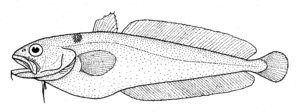Northern bastard codling facts for kids
Quick facts for kids Northern bastard codling |
|
|---|---|
 |
|
| Drawing by Dr Tony Ayling | |
| Scientific classification | |
| Synonyms | |
|
The northern bastard codling (Pseudophycis breviuscula) is a type of fish that lives in the ocean. It's found near southern Australia, including Tasmania, and New Zealand. This fish can live from the water's surface down to 220 meters deep. It usually grows to be about 15 to 25 centimeters long.
It looks a bit like other fish called rattails. It has big eyes and a long body that gets thinner towards the tail. However, the northern bastard codling has a separate, very round tail fin. Its second back fin and its belly fin both start about halfway along its body. The fish's body is a brown-pink color. Its back, tail, and belly fins have dark edges.
Contents
About the Northern Bastard Codling
What Kind of Fish Is It?
The northern bastard codling belongs to a group of fish called ray-finned fish. This group is known as Actinopterygii. It is part of the Gadiformes order, which includes all types of cod fish. This includes cod found in the ocean, freshwater, and brackish water (a mix of fresh and salt water).
The northern bastard codling is in the Moridae family. This family includes only cod-like fish that live in the ocean.
Family Members: Other Cod Species
The northern bastard codling is in the Pseudophycis genus. Fish in this group are only found in southern Australia and New Zealand. There are two other fish species in this group:
- Pseudophycis barbata, also known as the Southern bastard cod.
- Pseudophycis bachus, which is called the red codling.
These three species make up the Pseudophycis genus.
Physical Features of the Northern Bastard Codling
How Big Does It Get?
The northern bastard codling is the smallest of the red cod fish. It is thought to grow to a maximum size of about 25 centimeters (10 inches). Other red cod species can grow much larger, sometimes up to 90 centimeters (35 inches) long.
How to Tell It Apart from Other Cods
For many years, this fish was sometimes confused with the Southern bastard cod (P. barbata). You can tell it apart from the red codling (P. bachus) because it does not have a dark spot near its pectoral fin (the fin near its side). The northern bastard codling also has larger scales than the Southern bastard cod.
Fins and Body Color
This fish has two dorsal fins (back fins). The front one is quite short. The back dorsal fin stretches for more than half of its body length. Its caudal fin (tail fin) is rounded and not very wide.
The bottom part of its body is silver in color. The top part of its body is a pale pink-brown color. It has large eyes and a small whisker-like growth, called a barbel, on its chin.
Where It Lives and Its Home
A Mysterious Fish
The northern bastard codling is known as a 'cryptic fish'. This means it's hard to study and find. Its behavior and where it lives make it difficult for scientists to observe it. Cryptic species are often found only in one specific area.
Its Home in New Zealand
The northern bastard codling is a fish that lives only in the reefs of New Zealand. It prefers temperate (mild) ocean waters. Scientists believe it is active mostly at night. This nocturnal behavior is likely one reason why so little research has been done on this fish.
In New Zealand, the northern bastard codling has only been recorded around the North Island. It is seen more often on the eastern coast than on the western coast.
What the Northern Bastard Codling Eats
Its Diet
Not much is known about what the northern bastard codling eats. However, a study looked at the fish living on the reefs of the north-east coast. This study gave some clues about the diet of P. breviuscula.
The study found that it is a carnivore, meaning it eats meat. It is a benthic feeder, which means it finds its food on the ocean floor. It eats small crustaceans like amphipods, shrimps, and crabs. Scientists discovered this by examining the contents of the fish's stomachs. Because the fish is active at night, its feeding behavior could not be directly watched.
- Froese, Rainer and Pauly, Daniel, eds. (2006). "Pseudophycis breviuscula" in FishBase. March 2006 version.

